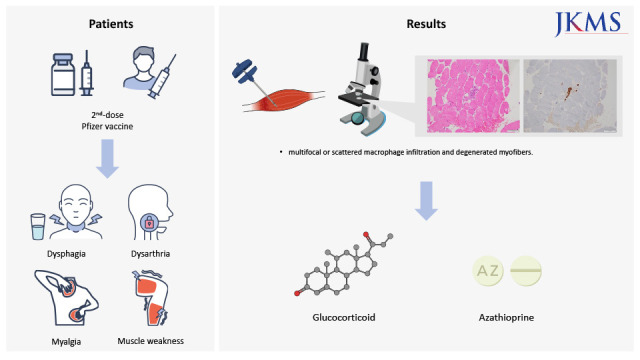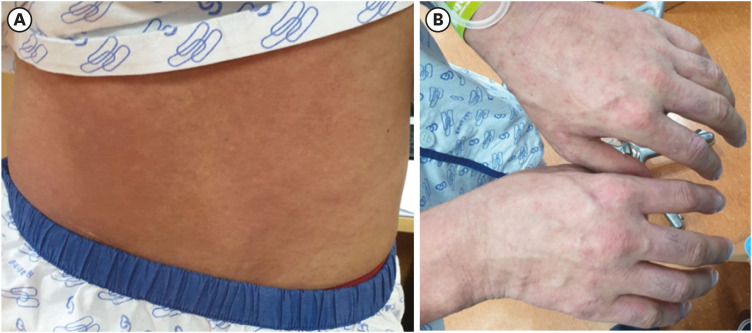1. Wang L, Xiang Y. Spike glycoprotein-mediated entry of SARS coronaviruses. Viruses. 2020; 12(11):1289.
2. Polack FP, Thomas SJ, Kitchin N, Absalon J, Gurtman A, Lockhart S, et al. Safety and efficacy of the BNT162b2 mRNA Covid-19 vaccine. N Engl J Med. 2020; 383(27):2603–2615. PMID:
33301246.
3. Oliver SE, Gargano JW, Marin M, Wallace M, Curran KG, Chamberland M, et al. The advisory committee on immunization practices’ interim recommendation for use of Pfizer-BioNTech COVID-19 vaccine - United States, December 2020. MMWR Morb Mortal Wkly Rep. 2020; 69(50):1922–1924. PMID:
33332292.
4. Remmel A. Why is it so hard to investigate the rare side effects of COVID vaccines? Nature. Forthcoming. 2021; DOI:
10.1038/d41586-021-00880-9.
5. Gherardi RK, Authier FJ. Macrophagic myofasciitis: characterization and pathophysiology. Lupus. 2012; 21(2):184–189. PMID:
22235051.
6. Israeli E, Agmon-Levin N, Blank M, Shoenfeld Y. Macrophagic myofaciitis a vaccine (alum) autoimmune-related disease. Clin Rev Allergy Immunol. 2011; 41(2):163–168. PMID:
20882368.
7. Kim H, Lim KY, Kang J, Park JW, Park SH. Macrophagic myofasciitis and subcutaneous pseudolymphoma caused by aluminium adjuvants. Sci Rep. 2020; 10(1):11834. PMID:
32678281.
8. Schmidt J. Current classification and management of inflammatory myopathies. J Neuromuscul Dis. 2018; 5(2):109–129. PMID:
29865091.
9. Khosla SG, Nylen ES, Khosla R. Rhabdomyolysis in patients hospitalized with COVID-19 infection: five case series. J Investig Med High Impact Case Rep. 2020; 8:2324709620984603.
10. Rivas-García S, Bernal J, Bachiller-Corral J. Rhabdomyolysis as the main manifestation of coronavirus disease 2019. Rheumatology (Oxford). 2020; 59(8):2174–2176. PMID:
32584414.
11. Aschman T, Schneider J, Greuel S, Meinhardt J, Streit S, Goebel HH, et al. Association between SARS-CoV-2 infection and immune-mediated myopathy in patients who have died. JAMA Neurol. 2021; 78(8):948–960. PMID:
34115106.
12. Alrubaye R, Choudhury H. Severe rhabdomyolysis in a 35-year-old woman with COVID-19 due to SARS-CoV-2 infection: a case report. Am J Case Rep. 2020; 21:e926733. PMID:
32801291.
13. Walsh EE, Frenck RW Jr, Falsey AR, Kitchin N, Absalon J, Gurtman A, et al. Safety and immunogenicity of two RNA-based Covid-19 vaccine candidates. N Engl J Med. 2020; 383(25):2439–2450. PMID:
33053279.
14. Roncati L, Nasillo V, Lusenti B, Riva G. Signals of T
h2 immune response from COVID-19 patients requiring intensive care. Ann Hematol. 2020; 99(6):1419–1420. PMID:
32382776.
15. Kaulen LD, Doubrovinskaia S, Mooshage C, Jordan B, Purrucker J, Haubner C, et al. Neurological autoimmune diseases following vaccinations against SARS-CoV-2: a case series. Eur J Neurol. 2022; 29(2):555–563. PMID:
34668274.
16. Nassar M, Chung H, Dhayaparan Y, Nyein A, Acevedo BJ, Chicos C, et al. COVID-19 vaccine induced rhabdomyolysis: case report with literature review. Diabetes Metab Syndr. 2021; 15(4):102170. PMID:
34186348.
17. Maramattom BV, Philips G, Thomas J, Santhamma SG. Inflammatory myositis after ChAdOx1 vaccination. Lancet Rheumatol. 2021; 3(11):e747–e749. PMID:
34585145.
18. Ramalingam S, Arora H, Lewis S, Gunasekaran K, Muruganandam M, Nagaraju S, et al. COVID-19 vaccine-induced cellulitis and myositis. Cleve Clin J Med. 2021; 88(12):648–650. PMID:
34857596.
19. Kim D, Choi JH, Jang JY, So O, Cho E, Choi H, et al. A case report for myopericarditis after BNT162b2 COVID-19 mRNA vaccination in a Korean young male. J Korean Med Sci. 2021; 36(39):e277. PMID:
34636504.
20. Choi S, Lee S, Seo JW, Kim MJ, Jeon YH, Park JH, et al. Myocarditis-induced sudden death after BNT162b2 mRNA COVID-19 vaccination in Korea: case report focusing on histopathological findings. J Korean Med Sci. 2021; 36(40):e286. PMID:
34664804.
21. Kim G, Choi EJ, Park HS, Lee JH, Lee JH, Lee KH. A case report of immune thrombocytopenia after ChAdOx1 nCoV-19 vaccination. J Korean Med Sci. 2021; 36(43):e306. PMID:
34751013.
22. Park JW, Yu SN, Chang SH, Ahn YH, Jeon MH. Multisystem inflammatory syndrome in an adult after COVID-19 vaccination: a case report and literature review. J Korean Med Sci. 2021; 36(45):e312. PMID:
34811978.






 PDF
PDF Citation
Citation Print
Print





 XML Download
XML Download